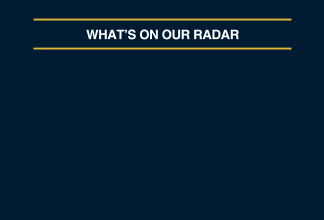Putting Market Volatility into Context
Written by The Content Team
Published on March 20, 2020
minute read
Share:
The following commentary was first published by RBC Global Asset Management in a report titled Looking Beyond the Clouds.
The situation surrounding the Covid-19 pandemic continues to evolve quickly. Amidst recent volatility, it's undoubtedly been a difficult time to be an investor. Not only do you have to worry about the value of your investments fluctuating, but you're also facing concerns about your family's and your personal health.
A look at the forecast
At times like these, it's challenging to ignore the noise. With markets focused on the latest Covid-19 developments, the short-term outlook is cloudy. However, what's often overlooked at times of heightened uncertainty is the long-term outlook – which often becomes clearer for investors.
Amidst recent uncertainty, the S&P 500 has declined roughly 30% from the all-time high it set on February 19, 2020. While the speed of the pullback has been fast, the depth of the drawdown is by no means unprecedented. In fact, dating back to 1950, the broad U.S. equity index has experienced five other pullbacks of at least 30 per cent. And, the forward looking returns from these points in time have represented fruitful opportunities for investors. While it's quite possible the volatility may continue as the market wrestles with the uncertainties related to Covid-19, a focus towards the long term can help keep things in perspective.
Behavioural economics plays a role
From the field of behavioural economics, the concept of loss aversion states that individuals would rather avoid losses than acquire equivalent gains. As a result, when you see the value of your investment portfolio decrease, it can trigger fear, making the decision of staying invested more challenging. In these situations, it's important to look beyond the recent volatility by asking yourself how you would invest your money today if all your assets were sitting in cash. With this as the starting point, it becomes easier to lay out the best investment plan for you moving forward.
The challenge is to see past today's clouds to have an eye on tomorrow's opportunities. As Wayne Gretzky so eloquently put it – "skate to where the puck is going to be, not to where it has been."
For a roundup of coronavirus coverage, plus timely reminders and tools that can help when markets are volatile, click here.
RBC Direct Investing Inc., RBC Global Asset Management Inc. and Royal Bank of Canada are separate corporate entities which are affiliated. RBC Direct Investing Inc. is a wholly owned subsidiary of Royal Bank of Canada and is a Member of the Investment Industry Regulatory Organization of Canada and the Canadian Investor Protection Fund. Royal Bank of Canada and certain of its issuers are related to RBC Direct Investing Inc. RBC Direct Investing Inc. does not provide investment advice or recommendations regarding the purchase or sale of any securities. Investors are responsible for their own investment decisions. RBC Direct Investing is a business name used by RBC Direct Investing Inc. ® / ™ Trademark(s) of Royal Bank of Canada. RBC and Royal Bank are registered trademarks of Royal Bank of Canada. Used under licence. © Royal Bank of Canada 2020. All rights reserved.
The views and opinions expressed in this publication are for your general interest and do not necessarily reflect the views and opinions of RBC Direct Investing. Furthermore, the products, services and securities referred to in this publication are only available in Canada and other jurisdictions where they may be legally offered for sale. If you are not currently resident of Canada, you should not access the information available on the RBC Direct Investing website.
Explore More

Here’s What Every Canadian Should Know About Estate Planning
Insights from Leanne Kaufman to help you feel more confident as you plan
minute read

3 Things We're Watching This Week
What the Inspired Investor team is watching
minute read

What’s Driving the Recent Surge in Gold Prices
Here are some things to watch with the gold market
minute read
Inspired Investor brings you personal stories, timely information and expert insights to empower your investment decisions. Visit About Us to find out more.







